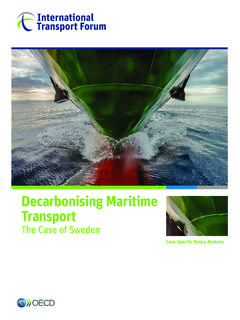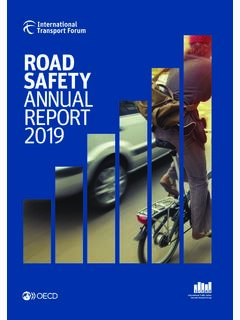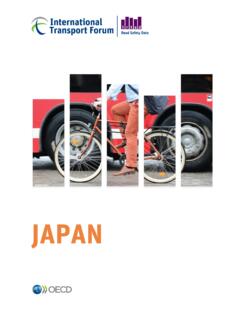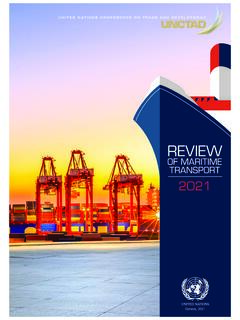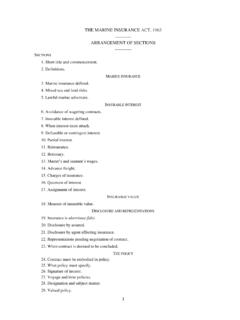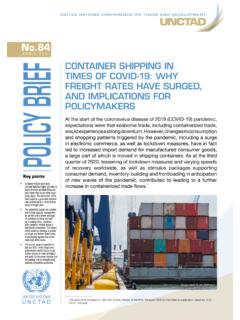Transcription of The Carbon Footprint of Global Trade - ITF
1 1 International Transport Forum: Global dialogue for better transportThe Carbon Footprint of Global TradeTackling Emissions from International freight Transport2= 30% of all transport-related CO2 emissions from fuel combustionCO2 emissions om eight7%of globalCO2 emissionsGrowth in international Trade has been characterised by globalisation and the associated geographical fragmentation of international production processes. Supply chains have become longer and more complex, as logistics networks link more and more economic centres across oceans and continents. Changing consumer preferences and new manufacturing requirements also affect international Trade and thus shape freight patterns.
2 This has led to more frequent and smaller freight shipments and, as a result, to less full containers, more empty runs and increased demand for rapid, energy-intensive transport such as air freight . As freight transport whether by air, land or sea relies heavily on fossil fuel for propulsion and is still a long way from being able to switch to cleaner energy sources, it is one of the hardest sectors to long-term impact of Global Trade on Carbon dioxide (CO2) emissions has been largely ignored. International Trade contributes to Global CO2 The issueCO2 emissions from Global freight transport are set to increase fourfoldGrowing concernProjected increase of CO2 emissions from Trade -related international freight3= 30% of all transport-related CO2 emissions from fuel combustionCO2 emissions om eight7%of globalCO2 emissionsFreightFreight20102108 Mt20508132 MtThe issueCO2 emissions from Global freight transport are set to increase fourfoldemissions mainly through freight transport.
3 The International Transport Forum (ITF) estimates that international Trade -related freight transport currently accounts for around 30% of all transport-related CO2 emissions from fuel combustion, and more than 7% of Global emissions. Projections based on the ITF s International freight Model foresee an increase of Trade -related freight transport emissions by a factor of to 2050. In the base year 2010, Global emissions from Trade -related freight transport are estimated to be 2 108 million tonnes (Mt) and could rise to 8 131 million tonnes under the baseline nearly fourfold increase would seriously undermine climate goals.
4 Assessing how changing Trade patterns will affect future CO2 emissions is important in establishing whether policies are aligned across the supply chain to achieve climate change mitigation Carbon Footprint of Global Trade - OECD/ITF 2015 4 The approachFrom Global Trade value to international freight volumesStandard projections of future Global Trade are expressed in value terms and do not take account of the physical transport activity involved. The ITF International freight Model projects international freight transport activity and related CO2 emissions up to 2050 under alternative Trade liberalisation scenarios.
5 The model expresses future Trade in value and volume (in USD, tonnes and tonne-kilometers) and assigns freight volumes to actual routes by transport mode - thus also enabling the calculation of related CO2 emissions. The starting point of the ITF model is OECD projections for international Trade at the level of 26 regions and 19 product groups. To obtain a realistic picture of how these Trade projections translate into freight movements, four additional layers are built into the model: First, Trade flows are disaggregated into production and consumption centres around the world, representing pair-wise Trade flows between nearly 300 such centroids.
6 Second, a mode choice model assigns the transport mode (sea, air, road, rail) used for Trade between each origin-destination pair by product group. The model is calibrated using European and Latin American data on Trade by mode for different products and also takes into account travel time and distance between trading partners as well as the existence of Trade agreements and a land border between trading , a weight-to-value model, calibrated again with European and Latin American Trade data on value/weight ratios for different commodities, is applied to obtain freight volumes from Trade projections. Again, the model takes into account travel time and distance, Trade agreements, land borders and common languages among other things as explanatory variables for Trade between different countries for each commodity.
7 Economic profile variables are also included to describe Trade relations between countries with different production sophistication and intensity of Trade . OECD Trade Projections Projections on future Global Trade in value termsGlobal transport network All ports, train stations, routes, Links between modes Dwelling timesValue to weight conversion In tonne-kilometre By origin-destination pairFreight modechoice Includes multimodal routes Includes economic profile Includes direct borders, Trade agreementsITFF reight Projections Assigment of freight volume to routes by transport modes++++= 19 product groups 26 zones 294 centroids covering 2 539 citiesProduction/ consumptioncentres5 The approachFrom Global Trade value to international freight volumesFinally, the resulting Trade by mode in tonnes of goods moved by product group is assigned to a Global freight transport network model.
8 This consolidates all freight networks in the world based on open GIS data. It includes all world highways and main roads, rail stations and networks, sea ports and actual routes as well as airports and commercial flights in a routable intermodal network connecting all production and consumption centres around the world. Each seaport and airport is connected to road and rail networks with intermodal dwelling times, reflecting the multimodal nature of most freight journeys. The model also includes differentiated speed for each link and border crossing times. For the first time, the ITF International freight Model allows the calculation of the domestic share of international Trade and the CO2 emissions associated with it.
9 Contrary to common modeling approaches, Trade does not stop at ports. Goods transported by road or rail from (or to) centres of production or consumption to (or from) ports are a significant element of international freight . However, this domestic share of international Trade -related freight is not accounted for in previous Global freight models. Linking the information on Global production and consumption centres with the Global freight network model enables the ITF International freight Model to estimate the domestic share of international freight for a country, providing insights into how an important segment of the freight journey can be shaped by domestic transport Trade Projections Projections on future Global Trade in value termsGlobal transport network All ports, train stations, routes.
10 Links between modes Dwelling timesValue to weight conversion In tonne-kilometre By origin-destination pairFreight modechoice Includes multimodal routes Includes economic profile Includes direct borders, Trade agreementsITFF reight Projections Assigment of freight volume to routes by transport modes++++= 19 product groups 26 zones 294 centroids covering 2 539 citiesProduction/ consumptioncentresThe Carbon Footprint of Global Trade - OECD/ITF 2015 6CO2 Emissions (million tonnes) freight Volumes (billion tonne-km)20102050 North America201020502010205020102050201020502 0102050201020502010205020102050201020502 010205020102030 North AtlanticSouth AmericaIndian OceanMediterranean and Caspian SeaNorth Paci cSouth Paci cOceaniaAfricaSouth AtlanticEuropeAsia+374%+273%+403%+332%+2 70%+191%+406%+315%+715%+689%+280+195 More freight , more CO2 International Trade -related freight and associated emissions by corridor7CO2 Emissions (million tonnes) freight Volumes (billion tonne-km)
